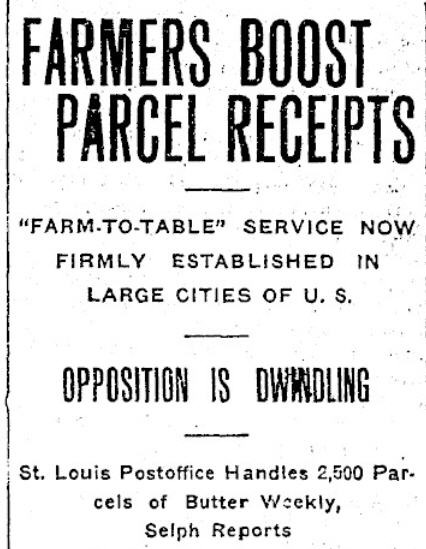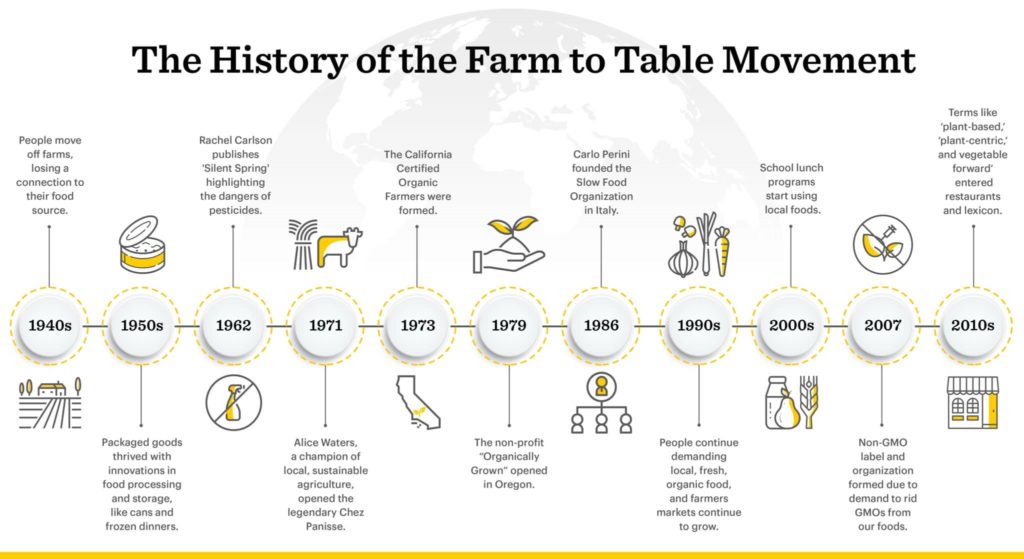The Farm-To-Table Movement or, as some call it, Farm-To-Fork isn’t new. While it seems to be all the rage currently it does have a history going back to early 1900s. You’ve read about what it is in my previous article, now let’s look at where it came from and why it is gaining such momentum.
The original farm-to-table was actually started around 1914 as a postal initiative to transport produce and other items directly from rural areas into the cities. This program picked up butter, eggs, poultry, vegetables, and other items to quickly deliver to their destination. It started with twelve post offices and was believed to be a way to make food less expensive. Farmers were invited to register and designate what they had to offer. Lists were put together and distributed, this version of mail order was so popular that an additional eighteen post offices were added.
It became quite popular because not only were people getting their needs met at a lower cost and delivered right to their door but farmers had a much better income and had a lot less waste. This service was heavily opposed by green grocers and butchers but it began to dwindle.

Of course there were problems with things arriving before they’d spoiled, using correct packaging and more. Packaging changed through the years it was in service but there were still some issues with timeliness and such.
This program lasted until 1920 when Congress decided to eliminate the funding for many reasons; the end of WWI reduced the public’s tolerance of the inconvenience, Congress was not willing to fund a program that was tied to a war, self-serve grocery stores lured people away and problems with time-sensitive delivery of fragile foodstuffs could be a problem.
Life began anew with people going to markets and picking up what they wanted. Grocers were finding what they needed in many ways which pushed out local farms when what grocers wanted could be found elsewhere and brought in for less price to them. Local farms began losing.
In the 40s people started to move away from farms and by the 50s processed foods were everywhere. Canned goods had become all the rage because food could last longer than having fresh and it didn’t need to be refrigerated. It didn’t take long though before people started to question pesticide usage. As you’ll see in the image below an article questioning pesticides was published in 1962.

In 1971, Berkeley, California (my home state) Chez Panisse opened. Alice Walters and friends wanted to do locally sourced food and begin the pull away from processed, don’t know where it came from food. Until this point in fine dining, especially on the East Coast, technique was the concern in restaurants, not ingredients, and it was also heavily influenced by sauces. Alice’s ideas were revolutionary. Instead of figuring out how many different things she could do with canned peaches, she wanted to know where and how to get a fresh peach. To learn about Chez Panisse you can click here for their history, how they operate, and more. If you’re ever in Berkeley and have the money to spare I highly suggest this establishment, it is truly divine and an amazing experience.
As Rutgers outlines, there are four pillars to the farm-to-table (farm-to-fork) movement:
- Food security. The farm to table movement increases the scope of food security to move beyond the food needs of individuals or families and look at the needs of both the larger community, with a focus on low-income households. “It has a strategic goal of developing local food systems,” the article notes.
- Proximity. The farm to table movement hinges on the notion that the various components of a food system (or a restaurant) should exist in the closest proximity to each other as possible. The goal is to develop relationships between the various stakeholders in a food system such as “farmers, processors, retailers, restaurateurs, consumers” and more. Additionally, proximity reduces the environmental impact of transporting ingredients across states or countries.
- Self-reliance. One of the goals of farm to table is to generate communities that can meet their own food needs, again eliminating the need for outside resources or long distance transportation of food.
- Sustainability. The core idea here is that farm to table food systems exist in a way that doesn’t stifle “the ability of future generations to meet their food needs,” meaning that it doesn’t destroy resources in the process.”
If you look around and think about it you’ll notice as time has passed there’s been an uptick to things like farmer’s markets. I remember as a child in the 70s, there were a few vendors at the local flea market on the weekends but really nothing more. In the 80s I remember there being weekend markets in other cities but a lot of these were handmade goods more than they were selling produce and things of that nature. The Civic Center in Marin County (where I’m from) was the farmer’s market to go to because there were more farmers, more vendors and it was generally a good time. In a recent web search, I’ve found that there are now over 200 farmers at this market each week. The Marin County farmer’s market is run by the Agricultural Institute of Marin and their website states “AIM serves 350+ farmers, food purveyors, and artisans from 38 California counties who participate in AIM’s eight Certified Farmers Markets across the Bay Area. Our goal is to showcase the benefits of buying locally grown, raised, sourced and products directly from the producer”. You can see this is definitely the way people are now preferring to shop.
Some organizations help bring fresh from farm to buyer in areas that might not have year-round farming due to weather, may have lower income, and other factors. I fell in love with Bountiful Baskets while I lived in Nevada and was blessed to still have them when I moved back to Colorado. This organization buys produce, breads and sometimes other items as a co-op. These items may not be locally sourced due to climate but they do know the farm they are dealing with and you are getting organic.
Where I am now I am spoiled by year-round farms and stand alone markets that bring the best in from these farms. I am able to provide the latest in seasonal, organic, farm fresh to my customers. I have a butcher I am able to shop with where I can find out exactly where my meat came from and how it was processed. Often they offer up this information without being asked because they know more and more people are doing organic and farm-to-fork at home.
Over 1200 school districts across the nation have moved to locally sourced fruits and vegetables to feed their students, spme schools even have their own gardens so children are learning not only about farm-to-table but how to grow their own.
Many urban communities across the nation have co-op farms where multiple people can pay for a plot and grow, then trade some of what they have for some of what another has and the whole community flourishes. I’ve even heard about roof-top growing in places like New York City.
The pull is now away from canned, heavily salted, precooked and mushy vegetables with little nutritional value and not knowing where it came from to locally sourced.
This is a movement I hope will continue gaining steam until small farms are again in the spotlight of how this nation eats and large processed food plants are a thing for our history books.
Head out to your farmer’s market, get to know the farmers, and the vendors. Who knows what you might find, what new friend you might make, what memories may come from this outing and what sort of amazing, fresh food will be on your table bursting with color and flavor.

